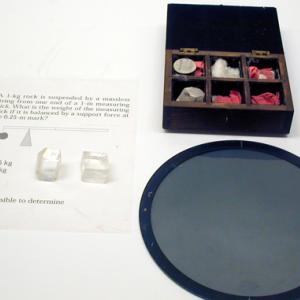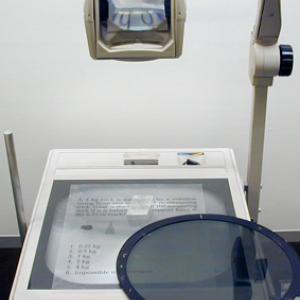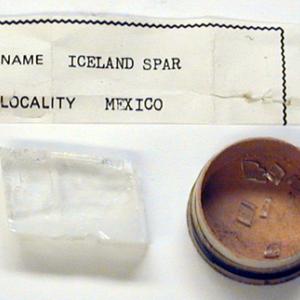College of Liberal Arts & Sciences
6H35.15 - Polarization - Calcite & Iceland Spar
The calcite shows double refraction in crystals. Place the calcite crystal over one of the transparencies on the overhead projector. Your should see two sets of words, one set is produced by the ordinary rays while the other is produced by the extraordinary rays. With a polarizer you will now be able to selectively shut off either the ordinary or extraordinary ray.
Iceland spar is natural calcium carbonate mineral crystal. Usually in this form the natural defects prevent useful demonstrations.
- Thomas B. Greenslade Jr., "Polarized Light Demonstations with the Overhead Projector", TPT, Vol. 59, #8, Nov. 2021, p. 652.
- Paul Changnon, "Animated Displays IV: Linear Polarization", TPT, Vol. 31, #8, Nov. 1993, p. 489, referenced in Resource Letter TLC-1 Teaching Light and Color, Demonstration Experiments Resource Articles.
- G. R. Davies, "Polarized Light Corridor Demonstration", TPT, Vol. 28, #7, Oct. 1990, p. 464.
- Thomas B. Greenslade Jr., "Iceland Spar Crystal", AJP, Vol. 89, #4, April 2021, p. 341.
- C. Pontiggia, "Interference With Polarized Light", AJP, Vol. 39, #6, June 1971, p. 679.
- Flora Lichtman, "The Thousand-Year-Old Viking Sunstone", Popular Science, Vol. 284, #4, Apr. 2012, p. 33.
- G. D. Freier and F. J. Anderson, "Om-6", A Demonstration Handbook for Physics.
- G. D. Freier and F. J. Anderson, "Om-5", A Demonstration Handbook for Physics.
- O-625: "Calcite - Cellophane", DICK and RAE Physics Demo Notebook.
- George M. Hopkins, "Polarized Light", Experimental Science, p. 239.
- George M. Hopkins, "Polarized Light", Experimental Science, p. 233.
- John Henry Pepper, "Double Refraction and the Polarization of Light", Cyclopadic Science Simplified, p. 111.
- Borislaw Bilash II and David Maiullo, "Can you See Me Now", A Demo a Day: A Year of Physics Demonstrations, p. 322.
- Alan Holden and Phylis Morrison, "Sodium Nitrate", Crystals and Crystal Growing, p. 116.
- Alan Holden and Phylis Morrison, "Some Optical Experiments", Crystals and Crystal Growing, p. 235 - 248.
- Jearl Walker, "5.51. Colored Frost Flowers", The Flying Circus of Physics with Answers.
- Gerard L'e Turner, Nineteenth-Century Scientific Instruments, p. 154.
- Gordon McComb, "Experimenting With Calcite", Lasers, Ray Guns, & Light Cannons, p. 128 - 130.
- Isaac Asimov, "Trapping the Rainbow", Fantasy and Science Fiction Magazine, p. 132.
- Robert Ehrlich, "O.5. Calcite Crystal", Turning the World Inside Out and 174 Other Simple Physics Demonstrations, p. 174.
- C. Harvey Palmer, "Experiment C4: Double Refraction in Calcite", Optics - Experiments and Demonstrations, John Hopkins Press, 1962.
- C. Harvey Palmer, "Experiment C3: Simple Polarization Demonstrations", Optics - Experiments and Demonstrations, John Hopkins Press, 1962.
- T. D. Rossing and C. J. Chiaverina, "7.3. Polarization By Double Refraction: Birefringence", Light Science, Physics and Visual Arts, p. 157.
- Joseph Frick, "#196 - The Principal Analyzing Apparatus", Physical Technics: Or Practical Instructions for Making Experiments in Physics and the Construction of Physical Apparatus with the Most Limmited Means, p. 228.
- Joseph Frick, "#200 & 201 - Experiments on Double Refraction", Physical Technics: Or Practical Instructions for Making Experiments in Physics and the Construction of Physical Apparatus with the Most Limmited Means, p. 233 & 234.
- "Prism for Double Refraction", Pike's Illustrated Catalogue of Scientific & Medical Instruments, Pike's Illustrated Descriptive Catalogue of Optical, Mathematical, and Philosophical Instruments, 1984, p. 194.
Disclaimer: These demonstrations are provided only for illustrative use by persons affiliated with The University of Iowa and only under the direction of a trained instructor or physicist. The University of Iowa is not responsible for demonstrations performed by those using their own equipment or who choose to use this reference material for their own purpose. The demonstrations included here are within the public domain and can be found in materials contained in libraries, bookstores, and through electronic sources. Performing all or any portion of any of these demonstrations, with or without revisions not depicted here entails inherent risks. These risks include, without limitation, bodily injury (and possibly death), including risks to health that may be temporary or permanent and that may exacerbate a pre-existing medical condition; and property loss or damage. Anyone performing any part of these demonstrations, even with revisions, knowingly and voluntarily assumes all risks associated with them.



